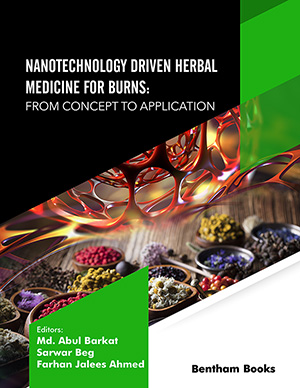Preface
Page: ii-iii (2)
Author: Md. Abul Barkat, Sarwar Beg and Farhan Jalees Ahmad
DOI: 10.2174/9789815039597121010002
Current Status and Future Outlook of Nanotechnology-Based Therapeutic Treatment Modalities for Burn Wound Management
Page: 1-20 (20)
Author: Rana Mazumder and Subhabrota Majumdar*
DOI: 10.2174/9789815039597121010004
PDF Price: $15
Abstract
Nanotechnology- Mediated Delivery of Phytomedicine for Burn Wound Healing
Page: 21-39 (19)
Author: Mohammed Aslam, Mohammad Zaki Ahmad, Abdul Aleem Mohammed, Harshita, Md. Abul Barkat and Javed Ahmad*
DOI: 10.2174/9789815039597121010005
PDF Price: $15
Abstract
Plant Mediated Green Synthesis of Silver Nanoparticles for Burn Wound Infections
Page: 40-65 (26)
Author: Katayoon Kalantari*, Alireza Kalantari and Thomas J. Webster
DOI: 10.2174/9789815039597121010006
PDF Price: $15
Abstract
Therapeutic Prospective of Green-synthesized Silver Nanoparticles in Burn Wound Management
Page: 66-88 (23)
Author: S. Sumathi*
DOI: 10.2174/9789815039597121010007
PDF Price: $15
Abstract
Phytochemical-Assisted Gold Nanoparticles for Burn Wound Management
Page: 89-104 (16)
Author: Abdelgadir A. Abdelgadir and Pooja A. Chawla*
DOI: 10.2174/9789815039597121010008
PDF Price: $15
Abstract
Therapeutic Importance of Phyto-assisted Green Synthesis of Zinc Oxide Nanoparticles in Burn Wound Management
Page: 105-116 (12)
Author: Md. Abul Barkat*
DOI: 10.2174/9789815039597121010009
PDF Price: $15
Abstract
Plant Mediated Synthesis of Titanium Dioxide Nanoparticles for Burn Wound Management
Page: 117-131 (15)
Author: Abdelgadir A. Abdelgadir and Pooja A. Chawla*
DOI: 10.2174/9789815039597121010010
PDF Price: $15
Abstract
Toxicity Related to Phytochemical-assisted Metallic Nanoparticles in Burn Wound Management
Page: 132-151 (20)
Author: Lubna Abidin, Mohd. Mujeeb* and Md. Abul Barkat
DOI: 10.2174/9789815039597121010011
PDF Price: $15
Abstract
A Novel Herbal Informatic Approach for the Management of Skin Burn Injury
Page: 152-174 (23)
Author: Ankit Tanwar*, Ruby Sharma, Ayesha Ali Zaidi, Deepti Sharma, Rashmi Wardhan, Raman Chawla, Himanshu Ojha, Rajesh Arora and Haider Ali Khan
DOI: 10.2174/9789815039597121010012
PDF Price: $15
Abstract
Skin burn injury is a prominent unintended injury that results in lifelong
physical and mental scarring, causing pain and subsequent mortality. Notwithstanding
a considerable decrease in their incidence, burn injuries remain as one of the most
common forms of trauma and also account for affecting the mental health, quality of
life all around the globe. Burn injuries can be managed using chemotherapeutic
modalities and have always been the domain of burn consultants. According to the
WHO (world health organization), approximately 1,80,000 deaths occur every year that
are caused by burns, and the vast majority occur in countries with low and middleincome.
This incidence is higher due to illiteracy, poverty, and lack of safety
awareness. Despite the availability of numerous therapeutic moieties and ointments
available commercially, people are more converging on the herbals remedies due to
their holistic approach and less toxic effects. In this book chapter, we are focusing on
the novel Herbal Informatic model for the identification of ethnopharmacologically
based predominant phytoconstituents or Nano-phytomedicines (NPs) for the
management of skin burn injury. This model was pre-validated by Tanwar et al., on
several disease models such as Autoimmune disorders like Rheumatoid Arthritis (RA),
Gout; Metabolic disorders like Diabetes, and several Nosocomial infections such as
Salmonella, E. coli, Clostridium species, etc. This novel tool involves the rationalebased
selection of herbals that could be an integrated ‘Herbal Informatics’ approach employing the use of both ethnopharmacological/traditional knowledge from the
Ayurvedic Medicinal System (AMS) and in silico bio-informatics search tools. This
combinatorial approach serves to retrieve information about a plant and reveals their
phytoconstituents based on medicinal properties for targeting virulence
factors/biomarkers involved in the progression of burn injury. In this chapter, we are
emphasizing the 5-major steps that are involved in scrutinizing the robust druggable
natural compounds that could be utilized to develop Nano-phytomedicines (NPs) for
the management of skin burn injury or burn sepsis and can also be effective in the drug
discovery process followed by study at in vitro and in vivo level.
Introduction
Burns can cause life-threatening injury and the lengthy hospitalization and rehabilitations required in burn therapy lead to higher healthcare costs. The risk of infection has also been one of the important concerns of burn wound management. The purpose of the burn wound care management is speedy wound healing and epithelization to limit the infection. The topical application of therapeutic agents is quintessential for the longevity of patients having significant burns. In recent times, research on herbal medicine for burn wound management has been vastly increased because of their safer toxicological profiles in contrast to synthetic medicines. Despite the promising therapeutic potential of herbal medicines in this area, herbal medications have some limitations which include low pharmacological activity, solubility and stability. Nanotechnology-based smart drug delivery approaches which involve the use of small molecules as nanocarriers, however, can help to overcome these biopharmaceutical challenges. This book provides an overview of plant-mediated metallic nanoparticulate systems and nanophytomedicine based therapeutic treatment modalities for burn wound lesions. Nine chapters deliver updated information about nanomedicines for burn wound therapy. Contributions are written by experts in nanomedicine and phytomedicine and collectively cover the pathophysiology of wound lesions, current and future outlook of nanomedicine based treatments for burn wound lesions, the role of biocompatible nanomaterials in burn wound management, plant-mediated synthesis of metal nanoparticles for treating burn wound sepsis, phytomedicine based nanoformulations and the phyto-informatics models involved in the wound healing process which are used to select appropriate nanotherapeutic agents. This reference serves as an accessible source of information on the topic of nanomedicine for burn treatments for all healthcare professionals (medical doctors, nurses, students trainees) and researchers in allied fields (pharmacology, phytomedicine) who are interested in this area of medicine.






















